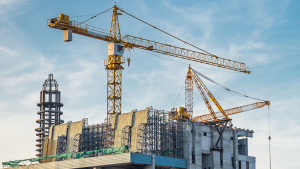The people at PCL knew they were developing something special in the smart building sphere when they received a shout-out from Sam George, director of Azure IoT at Microsoft. PCL’s Job Site Insights (JSI), the company’s smart construction platform was showcased in July during the keynote presentation at the Microsoft Inspire Conference in Las Vegas, Nevada.
Using JSI, construction sites are connected to Internet of Things (IoT) sensors throughout the project. The data collected is continuously streamed into the JSI cloud platform using the features and capabilities of Azure products, including Azure Maps and Azure IoT Spatial Intelligence. JSI will use both artificial intelligence and machine learning technologies to convert that data into real-time actionable insights available to construction site staff, partners, and owners.
Once buildings are commissioned, PCL is developing a partner product, Building Insights, which will allow building owners to manage, maintain and operate buildings more efficiently.
Mark Bryant, chief information officer at PCL Construction, has been leading the effort to transform the business from a successful construction company to a cloud-first information technology company that happens to be a construction leader.
Q: Where did the digital transformation of PCL begin?
MB: Five years ago, PCL implemented a technology initiative based on four pillars: cloud, mobility, analytics, and integration. We started by moving most of our traditional IT processes and infrastructure to the cloud. Already, we’ve seen increased productivity, decreased risk and improved time-to-market. Along with our experience, data has become a critical asset. Our decisions are now data-driven.
Q: How do smart buildings fit into PCL’s evolution to a data-driven company?
MB: Using JSI, we can visualize the construction site through the eyes of highly capable sensors. We map the devices to spaces, equipment, assets and people. That allows project staff to monitor the entire digitalized job site through a single window. JSI further analyzes that data to make construction smarter, by enabling lean construction, reducing rework and warranty claims, improving on build quality, conserving energy, increasing productivity and safety, and reducing PCL’s carbon footprint.
Q: Why did you decide to partner with Microsoft to develop JSI?
MB: People often think of Microsoft as a company so big it doesn’t need to innovate. We were impressed by the fact that, through Azure, Microsoft is just as agile and innovative as the best technology companies out there. The construction initiative was just as important to Microsoft as it is to us, and we announced our partnership through a joint press release in April. We’re one of a few companies worldwide who are using technologies offered by Azure that have not yet been made available to the general market.
Q: How are you developing JSI to be certain it works in the field?
MB: We’ve been using many of the features of JSI as we completed the 69-storey Stantec Tower in Edmonton. We’re also establishing pilots in Toronto, Minneapolis and Los Angeles to perfect the technology.
Q: Give us a real-life example.
MB: At the Stantec Tower we had sensors measure the humidity of the suites so that we could install millwork when humidity levels were optimal. It takes some of the human element out of conducting frequent manual checks for optimal conditions before work can begin. We’re also saving energy by monitoring the heat and humidity of each of the suites to keep them at optimal temperatures.
Q: We hear a lot about the IoT, which relies on sophisticated sensors to collect data to be processed. What sorts of sensors are available for construction applications?
MB: We’ve built the platform to be agnostic, so we can employ new sensors from any developer. We can keep track of material and people. We can keep track of motion, heat, vibration, barometric pressure and volatile organic compounds. We can only imagine what sorts of sensors are currently under development.
Q: Where does Building Insights come in?
MB: Many of the sensors we’re using to improve our quality, safety and efficiency can also be used by the occupant, as part of our Building Insights platform. It’s built on Azure IoT’s spatial intelligence capabilities, which allow better management of heating, cooling, and room-booking systems based on how space is actually used by occupants. It also employs Azure Digital Twins, which enables users to create digital models of any physical environment, and to query data in the context of the entire space, not just the individual sensors.
Q: How does that generate an advantage for building owners?
MB: The buzz in the construction marketplace is around the cost of building maintenance and energy consumption. Suppose you could create a lighting system that turned on only when occupants were in the area? Or build a maintenance schedule around the actual use of washrooms and common areas, rather than a fixed time schedule? What if you could know that an elevator was going to require maintenance before it was actually required? You could schedule the maintenance during off-hours without losing any elevator time.
Q: How can occupants benefit from smart buildings?
MB: IoT can give folks greater control over features and functions that increase occupant comfort, make them feel safer and improve their experience inside the building. It’s the difference between offering a facility where people want to be as opposed to cattling them in a building for 10 hours before you send them home.
Q: Why is this work important to PCL?
MB: Smart cities require smart buildings and we’re creating the building blocks for a sustainable and connected urban future. It’s an exciting time to be in construction IT and even more exciting to have a Canadian construction company leading the way.
This content is sponsored by PCL Construction in collaboration with ConstructConnect® Media. To learn more about PCL visit www.pcl.com.




Recent Comments
comments for this post are closed